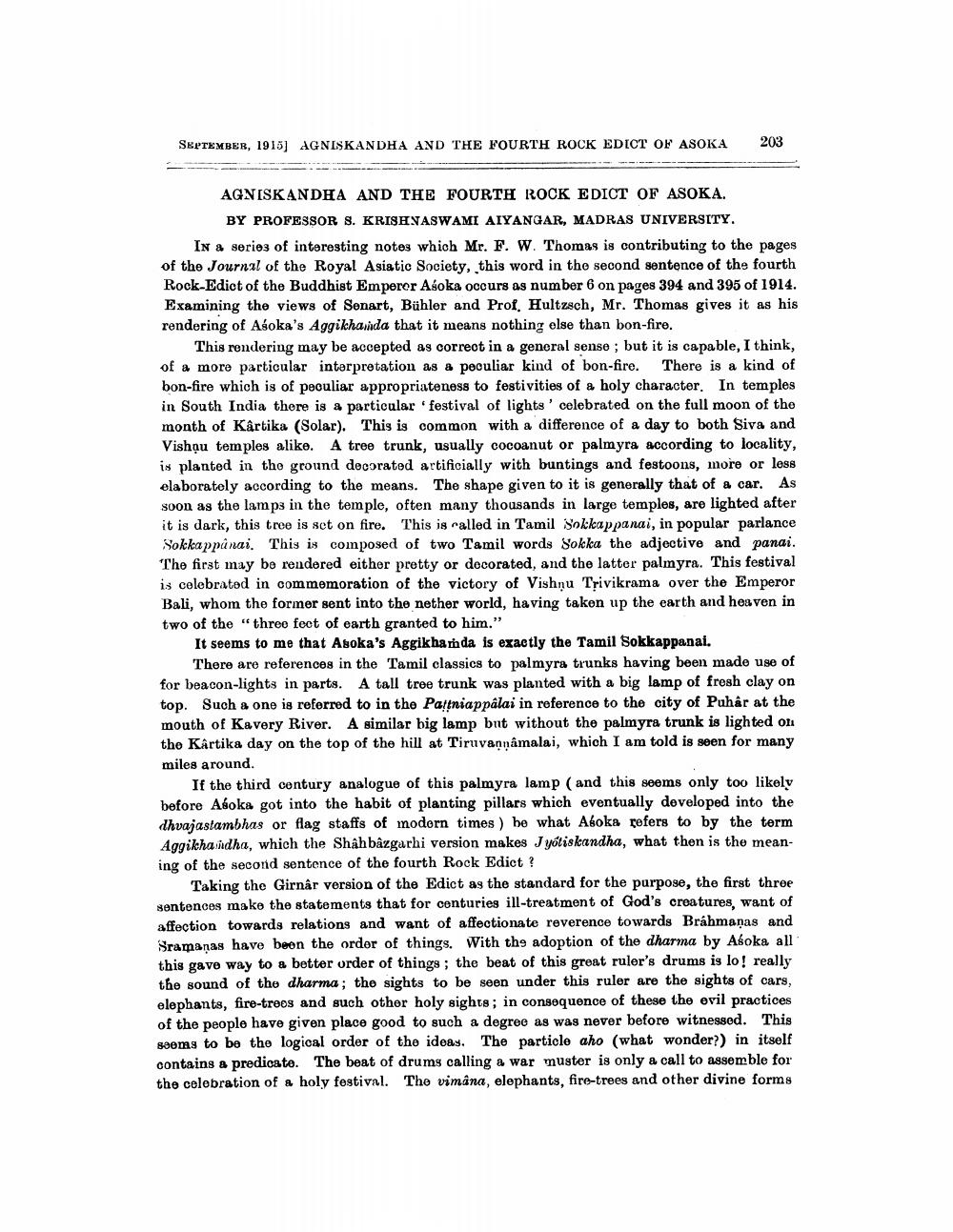________________
SEPTEMBER, 1915] AGNISKANDHA AND THE FOURTH ROCK EDICT OF ASOKA
203
AGNISKANDHA AND THE FOURTH ROCK EDICT OF ASOKA.
BY PROFESSOR S. KRISHNASWAMI AIYANGAR, MADRAS UNIVERSITY. In a series of interesting notes which Mr. F. W. Thomas is contributing to the pages of the Journal of the Royal Asiatic Society, this word in the second sentence of the fourth Rock-Edict of the Buddhist Emperor Asoka occurs as number 6 on pages 394 and 395 of 1914. Examining the views of Senart, Bühler and Prof. Hultzsch, Mr. Thomas gives it as his rendering of Asoka's Aggikha da that it means nothing else than bon-fire.
This rendering may be accepted as correct in a general sense ; but it is capable, I think, of a more particular interpretation as a peculiar kind of bon-fire. There is a kind of bon-fire which is of peouliar appropriateness to festivities of a holy character. In temples in South India there is a particular festival of lights' celebrated on the full moon of the month of Kartika (Solar). This is common with a difference of a day to both Siva and Vishņu temples alike. A tree trunk, usually cocoanut or palmyra according to locality, is planted in the ground decorated artificially with buntings and festoons, more or less elaborately according to the means. The shape given to it is generally that of a car. As soon as the lamps in the temple, often many thousands in large temples, are lighted after it is dark, this tree is set on fire. This is ralled in Tamil Sokkappanai, in popular parlance Sokkappanai. This is composed of two Tamil words Sokka the adjective and panai. The first may be rendered either pretty or decorated, and the latter palmyra. This festival is celebrated in commemoration of the victory of Vishnu Trivikrama over the Emperor Bali, whom the former sent into the nether world, having taken up the earth and heaven in two of the "three feet of earth granted to him."
It seems to me that Asoka's Aggikhamda is exactly the Tamil Sokkappanai.
There are references in the Tamil classics to palmyra trunks having been made use of for beacon-lights in parts. A tall tree trunk was planted with a big lamp of fresh clay on top. Such a one is referred to in the Pattniappalai in reference to the city of Puhâr at the mouth of Kavery River. A similar big lamp but without the palmyra trunk is lighted of the Kartika day on the top of the hill at Tiruvannamalai, which I am told is seen for many miles around.
If the third century analogue of this palmyra lamp (and this seems only too likely before Asoka got into the habit of planting pillars which eventually developed into the dhvajastambhas or flag staffs of modern times) be what Aboka refers to by the term Aggikha idha, which the Shah bâzgarhi version makes Jyotiskandha, what then is the meaning of the second sentence of the fourth Rock Edict?
Taking the Girnar version of the Edict as the standard for the purpose, the first three sentences make the statements that for centuries ill-treatment of God's creatures, want of affection towards relations and want of affectionate reverence towards Brahmaņas and Sramanas have been the order of things. With the adoption of the dharma by Asoka all this gave way to a better order of things; the beat of this great ruler's drums is lo! really the sound of the dharma; the sights to be seen under this ruler are the sights of cars, elephants, fire-troos and such other holy sights; in consequence of these the evil practices of the people have given place good to such a degree as was never before witnessed. This seems to be the logical order of the ideas. The particle aho (what wonder?) in itself contains a predicate. The beat of drums calling a war muster is only a call to assemble for the celebration of a holy festival. The vimana, elephants, fire-trees and other divine forms




